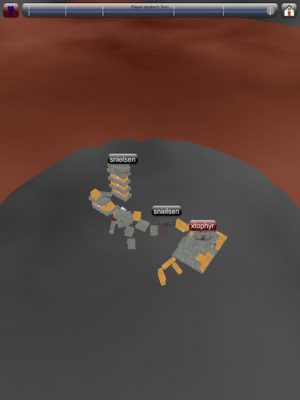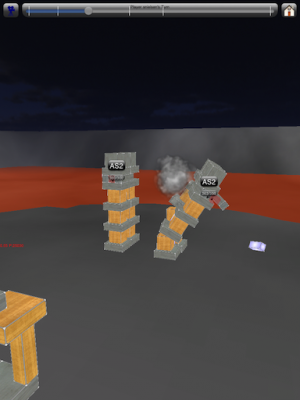Introduction to Cannonade | |
| April 2nd, 2011 | |
 |
Even though many of you already know about my current project (I have also written a few blog posts about it) it is time to officially announce it and give it a quick introduction. The first project that I have chosen to work on since going indie again is an iOS game called “Cannonade”. It is a turn-based physics game with an emphasis on multiplayer and creativity. So far I have the core engine up and running. I have chosen to use the Bullet3D engine for physics simulation because of it’s general support and stability, iOS support and iOS performance. The rendering and effects engine, UI, networking engine and everything else I am writing from scratch myself. I am basing enough crucial functionality on iOS specific components (like UIKit and Game Center) that I can say with good confidence that it is going to be an iOS exclusive (although some parts of the engine may make it to other platforms). It is currently in early Alpha and there is a lot of game design and asset creation left to do. Things are still very malleable and everything is still placeholder (please keep that in mind when playing test versions and viewing screenshots 😉 ). I have a comprehensive testing plan, work schedule and timetable which I am hoping will ensure that Cannonade becomes a polished, high quality product by the time it hits the App Store.
Gameplay Explained
 |
 |
Each player in the game is given a castle made up of blocks of various shapes, sizes and material types. All of the castles are placed together in an arrangement facing each other on a terrain map of varying height and shape. Among the blocks that make up each castle there are a few special blocks (currently) called “turrets”. When it is a player’s turn they can chose to use up resources to fire projectiles and other weapons at their opponents from these turrets. Once all of a player’s turrets have been destroyed (by depleting their hit points) they are out of the game. The last player standing is the winner of the game.
Each player can chose their own castle design to play with or they can create a new one with the editor. The editor (which exists outside the main game but still in the same application) allows players to design their own castles or make modifications to existing designs. Castle design allows players to express their creativity and employ inventive arrangements against their opponents. Such decisions as whether to put a turret atop the castle in a high position might give it a tactically offensive advantage because of its height and wide view of the opponents. However, that offensive advantage might also leave it open to attack and easy to knock off. Likewise a turret that is deeply surrounded and secured by large and heavy blocks might be very hard for opponents to dislodge but its height and viewing angle of the opponents will probably be limited. Thus there is strategy in how a player might design a castle for particular uses, game types and opponents.

Every time a player gets a turn they are issued a base amount of monetary resources. They can then use those resources to fire at their opponents with a weapon of their choosing for a cost. They can fire at their opponents as much as they want in a turn until their resources are depleted. They are not however obligated to fire any weapons at all during a turn and have the option of passing the turn to the next player. Because the player’s resource amounts accumulate and persist within the game, they can choose to conserve and save up resources. A player might want to build up resources so that they can afford to use more expensive and devestating weapons in a future turn. Also, when a player’s turret is destroyed an amount will be credited to that player who lost the turret and a lesser amount will be given to the player that destroyed it. This is intended to lend some elasticity and play balance to the game by giving players who are being pounded or ganged up on, extra resources with which to fight back with and even out the game. There is also the option for a player to immediately cash-in up to all but one of their turrets during their turn for the turret loss amount. This is a risky option that is intended to allow players who might be just barely out of range of making a devestating blow to their opponent(s) to obtain resources enough to execute their plans immediately during that turn at the cost of the loss of their own turret(s). If the player that cashes in turret(s) does not succeed in completely destroying their opponent(s) with that attack, they can possibly be in big trouble from retaliation. Thus there is a very easy to understand resource economy that also allows for deep variations in gameplay and strategy for players to explore and experiment around with.
Wanna Help?
A crucial part of my plan for success is testing. I want to get as many great volunteer testers as I can involved in testing regular builds early in the development process. My hope is that through the multiplayer emphasis and the tester resource site that I have set up, I can foster a community of active and productive users who not only help find bugs but who also help guide the game’s design and feel like they are a part of the project. Hopefully they will find the core mechanic as much fun as I do and can’t wait to see the changes in each week’s build! Would you like to be one of these awesome testers? Send an email to: [email protected] and I will reply with instructions on how to get onto the Trac server, Testflight list and tester forums.








